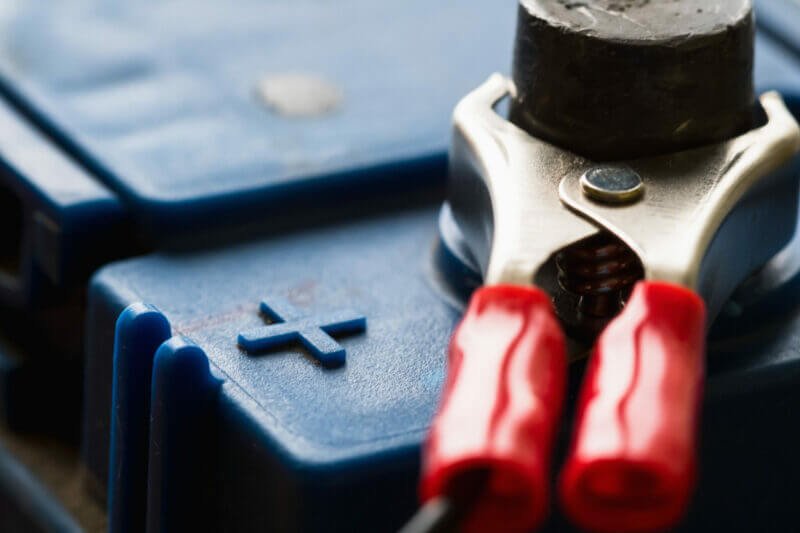Table of Contents Show
One of the main benefits of camping in an RV versus camping in a tent is the electricity available to power lights, appliances, and devices. So if you are an RV user, understanding the electrical system in your rig should be of great importance. And the central cog around which the entire system works is your battery, so let’s look at how this “energy-storing package” functions and how to charge it.
Things to Know about RV Batteries
Batteries that work best as RV coach batteries are deep cycle 6 volt or 12-volt batteries, as recreational vehicles are wired for 12-volt power. They are usually one of three types: lead-acid, AGM (absorbed glass mat), or lithium. Each of these types has different advantages and detriments to usage, including charging time, maintenance required, and how much of the stored energy that can be used before recharging is necessary.
Batteries for an RV have one job to do: store as much energy as they can. And they do this over and over and over again. The way they receive energy is varied, however. Power can come to the battery from:
- A power pole (shore power when plugged in)
- The alternator of the chassis battery (when a motorhome’s engine or the engine of a tow vehicle is running)
- RV Generator (think of it as your own little transportable power plant)
- Solar panels (that transfer solar power to the battery)
Lead Acid vs. Lithium Battery Charging
Lead-acid batteries are usually the most readily available and least expensive deep cycle batteries on the market. But they do have some drawbacks, including the need for monthly maintenance and the lack of charging speed.
Users can only utilize 50% of the energy stored in a lead-acid battery before they will need to be recharged. Due to the 3-stage processes needed, it can take a while depending on the size of your battery and convertor.
On the other hand, lithium batteries are known for their quick recharging speeds and the ability to use almost the entire amount of energy stored in them before requiring a recharge.
That, along with the cost of materials needed to create a lithium battery, is the reason these power packs are quite a bit more expensive. Their recharge times are much quicker, which can be the difference in having power when you most need it.
Does the RV Battery Charge When Plugged In?
When you plug into a power pole at a campground, your house batteries are being charged by the AC current from the power pole through your convertor.
If you are totally dependent upon using this method to recharge your batteries, it can take a while, especially if your batteries are lead-acid. But while they are being charged, you have the benefit of using DC power throughout your RV that comes straight from the pole.
Many campers boondock for several days, draining down the power in their batteries, then stay a night in an RV park to plug in and recharge before another boondocking stint.
How to Charge an RV Battery
As stated before, you can charge your batteries in a variety of ways. See below for the most common ways to charge an RV battery.
Plugged Into Campground Power Pole
When plugged into a power pole at a campground, your convertor will charge your batteries.
While Driving
If driving a motorhome, your house batteries will charge from the alternator in your engine as you drive. This is a great way to increase energy in the batteries as you move from one boondocking campsite to another.
Some trailers are also wired to receive a small charge from the tow vehicle when plugged in. The wire gauge is tiny so it will rarely be more than a trickle charge. Look into a DC-DC charger for a more substantial charge.
Generator
Use a generator to charge your batteries wherever you are camping (but not during campground “Quiet Hours!”).
This charges your batteries the same as if you are plugged into a power pole. Your generator supplies 120v AC to your RV’s converter which then charges your batteries.
Solar
A solar system can be added to your RV to collect solar power and store it in your coach batteries. However, this option requires more equipment than just solar panels.
A solar charger controller is required to not harm your batteries. It regulates the current and voltage coming from the solar panel to ensure that you don’t overcharge your battery.
RV Battery Monitors
To know exactly how much energy your batteries have and how much is being used, you may want to install a battery monitor. They come in all shapes and sizes. Installation requirements varying from just attaching one model to the poles on your battery to installing a gauge inside your RV. Some even allow accessing the information from a Bluetooth phone app.
These monitors should give you a sense of the batteries’ state and capacity. Many of the more intricate monitors will show gauges and meters of how much power is going out during usage and how much energy is being stored during recharging.
Charging Mistakes to Avoid
- Prevent overcharging and temperature extremes – with a battery controller, you should be able to avoid overcharging your batteries. The controller will limit or stop charging when the battery is full.
- When not using the RV battery, you should turn off the battery disconnect switch. So, when you put your trailer or coach into storage, it’s a good idea to disconnect the batteries or use a trickle charger.
- Keep sulfation at bay – with lead-acid batteries you may have a problem with sulfation and the gasses produced. Ensure the batteries are located in a vented bay and keep battery posts clean from buildup by using baking soda and a wire brush.
Knowing how your RV electrical system works and maintaining your batteries will give you peace of mind when it comes to using all of the bells and whistles that come with your recreational vehicle. You can enjoy the benefits of camping in the outdoors while making good use of your rig’s appliances and electrical devices inside, as well!






